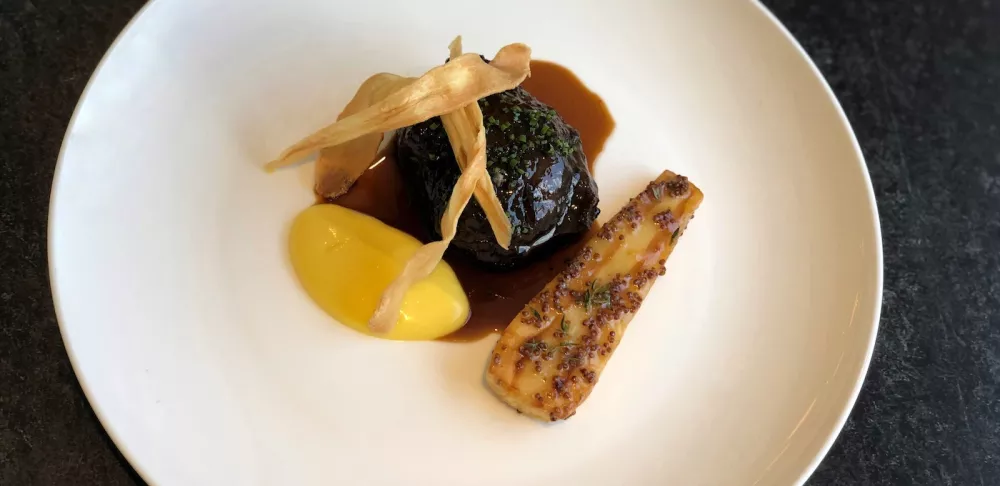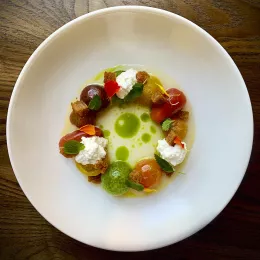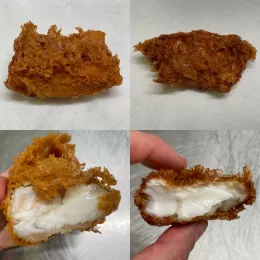Braising is a moist heat method in which an item is placed into a flavorful liquid, often containing alcohol and stock, and cooked slowly in an oven or on the stovetop until fork tender. It is best used to prepare tough proteins which contain a great deal of connective tissue or fat, breaking down the collagen over a long period of time and transforming it into gelatin which offers a great deal of flavor and texture.
There is an exchange of flavor between the item and its cooking vehicle (liquid), and often the liquid is strained and used to make an accompanying sauce or broth. Braised items tend to be rich in flavor and body, typically served with accompanying acidic items like wine to counter the heavy taste.
Beef cheek is a muscle that's extremely well worked as cows chew cud from the pasture. That makes this part of the animal very tough so it requires cooking for long periods of time at low temperatures. Beef cheeks are also extremely flavorful and when cooked taste characteristically beefy. They're rich and when cooked to fork tender have a soft and decadent texture.
Here, I'm serving it with a pear and saffron puree to balance richness with acidity and glazed parsnip in honey mustard and thyme for a sweet and earthy flavor, finished with crispy parsnip chips that provide contrasting texture and mouthfeel.
Braised Beef Cheek, Pear and Saffron Puree, Glazed Parsnips, Parsnip Chips
Yields 2 servings
Beef Cheek

Ingredients
- 2 beef cheeks
- 600 grams ale/bitter
- 600 grams veal stock, reduced by half to 300 grams
- 1 carrot, peel and diced
- 1/2 small onion, diced
- 1 rib celery, diced
- 1/2 head garlic
- 4 stems thyme
- 1 bay leaf
- Salt, as needed
- Pepper, as needed
- Grapeseed oil, as needed
- Unsalted butter
- 1/2 bunch chives, finely sliced
Directions
- Season beef cheeks with salt and pepper.
- Heat pan, add grapeseed oil and sear, browning evenly. Remove from pan.
- Add mirepoix and brown lightly.
- Deglaze pan with ale and scrape fond.
- Add veal stock, aromatics and cover with a cartouche. Braise in the oven for 4 hours at 165 C/325 F.
- When cooked, remove cheek from the pan and strain through a chinois.
- Reduce liquid to a sauce consistency.
- Monte with butter.
- Place cheek on a tray and spoon sauce over the beef to glaze.
- Sprinkle with chives.
Pear and Saffron Puree
Ingredients
- 3 pears, peeled, cored and sliced
- 1 pinch saffron
- Salt, as needed
- Sugar, as needed
- Extra virgin olive oil, as needed
Directions
- Place pear, saffron, salt and sugar into a sous vide bag.
- When tender, place into a blender. Blend until smooth, add EVOO, to taste.
Glazed Parsnips
Ingredients
- 1 parsnip, peeled and cut in two
- 8 grams honey
- 8 grams whole-grain Dijon mustard
- 2 sprigs thyme, picked
- Kosher salt, to taste
- Unsalted butter, as needed
- Canola oil, as needed
Directions
- Heat pan with canola oil.
- Add the parsnip and brown in the pan. Add butter and cook through. Season with kosher salt.
- Drain excess oil, turn off the heat, and add mustard, honey and thyme. Toss together.
- Serve immediately.
Parsnip Crisps
Ingredients
- 1 parsnip, peeled and sliced on a mandolin
- Maldon sea salt, as needed
- Vadouvan, as needed
Directions
- Heat oil to 165 C/325 F.
- Fry parsnip slices until crisp. Dust with salt and vadouvan if necessary.
Learn more wet and dry heat methods in Culinary Arts.




